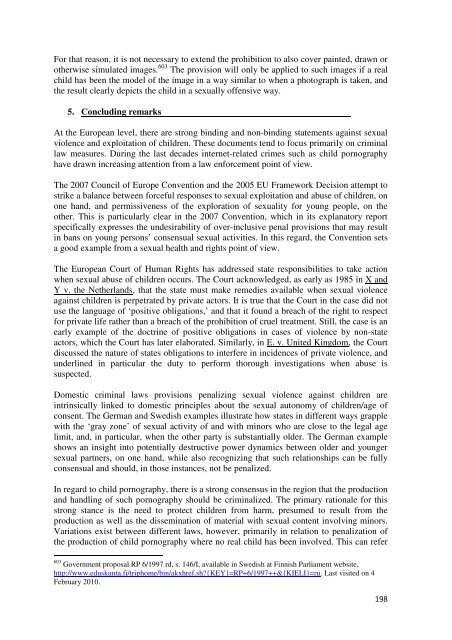Johanna Westeson - The ICHRP
Johanna Westeson - The ICHRP
Johanna Westeson - The ICHRP
You also want an ePaper? Increase the reach of your titles
YUMPU automatically turns print PDFs into web optimized ePapers that Google loves.
For that reason, it is not necessary to extend the prohibition to also cover painted, drawn or<br />
otherwise simulated images. 603 <strong>The</strong> provision will only be applied to such images if a real<br />
child has been the model of the image in a way similar to when a photograph is taken, and<br />
the result clearly depicts the child in a sexually offensive way.<br />
5. Concluding remarks<br />
At the European level, there are strong binding and non-binding statements against sexual<br />
violence and exploitation of children. <strong>The</strong>se documents tend to focus primarily on criminal<br />
law measures. During the last decades internet-related crimes such as child pornography<br />
have drawn increasing attention from a law enforcement point of view.<br />
<strong>The</strong> 2007 Council of Europe Convention and the 2005 EU Framework Decision attempt to<br />
strike a balance between forceful responses to sexual exploitation and abuse of children, on<br />
one hand, and permissiveness of the exploration of sexuality for young people, on the<br />
other. This is particularly clear in the 2007 Convention, which in its explanatory report<br />
specifically expresses the undesirability of over-inclusive penal provisions that may result<br />
in bans on young persons’ consensual sexual activities. In this regard, the Convention sets<br />
a good example from a sexual health and rights point of view.<br />
<strong>The</strong> European Court of Human Rights has addressed state responsibilities to take action<br />
when sexual abuse of children occurs. <strong>The</strong> Court acknowledged, as early as 1985 in X and<br />
Y v. the Netherlands, that the state must make remedies available when sexual violence<br />
against children is perpetrated by private actors. It is true that the Court in the case did not<br />
use the language of ‘positive obligations,’ and that it found a breach of the right to respect<br />
for private life rather than a breach of the prohibition of cruel treatment. Still, the case is an<br />
early example of the doctrine of positive obligations in cases of violence by non-state<br />
actors, which the Court has later elaborated. Similarly, in E. v. United Kingdom, the Court<br />
discussed the nature of states obligations to interfere in incidences of private violence, and<br />
underlined in particular the duty to perform thorough investigations when abuse is<br />
suspected.<br />
Domestic criminal laws provisions penalizing sexual violence against children are<br />
intrinsically linked to domestic principles about the sexual autonomy of children/age of<br />
consent. <strong>The</strong> German and Swedish examples illustrate how states in different ways grapple<br />
with the ‘gray zone’ of sexual activity of and with minors who are close to the legal age<br />
limit, and, in particular, when the other party is substantially older. <strong>The</strong> German example<br />
shows an insight into potentially destructive power dynamics between older and younger<br />
sexual partners, on one hand, while also recognizing that such relationships can be fully<br />
consensual and should, in those instances, not be penalized.<br />
In regard to child pornography, there is a strong consensus in the region that the production<br />
and handling of such pornography should be criminalized. <strong>The</strong> primary rationale for this<br />
strong stance is the need to protect children from harm, presumed to result from the<br />
production as well as the dissemination of material with sexual content involving minors.<br />
Variations exist between different laws, however, primarily in relation to penalization of<br />
the production of child pornography where no real child has been involved. This can refer<br />
603 Government proposal RP 6/1997 rd, s. 146/I, available in Swedish at Finnish Parliament website,<br />
http://www.eduskunta.fi/triphome/bin/akxhref.sh?{KEY}=RP+6/1997++&{KIELI}=ru. Last visited on 4<br />
February 2010.<br />
198
















